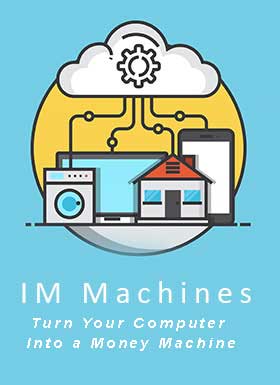Most creators are trying to build “relentless income” with tactics that guarantee the opposite: launch spikes, traffic panic, and permanent low-level stress.
Rob Cornish’s Relentless Income book is basically an antidote to that — and it maps perfectly onto what you’re doing with IMMachines and AI tools.
Below is a full breakdown of his Nano Book system, translated into a step-by-step roadmap for mid-life creators, coaches, consultants, and solopreneurs who want calm, compounding income rather than adrenaline-filled chaos.
The Big Idea: Relentless Income ≠ One Big Launch
Rob’s core message is simple:
Consistent £/$5K, £/$10K, or £/$30K+ months require a relentless supply of new customers — not occasional spikes.
He shows this with his own numbers: one-person business, home office, flexible lifestyle, roughly $40K/month average via Stripe plus PayPal and bank transfers — but the emphasis is not ego, it’s consistency and peace of mind. For the IMMachines audience, that’s huge:
-
It’s not about “hit £10K once and collapse”.
-
It’s about a system that quietly produces buyers every day.
-
It’s about identity and peace — knowing the bills are covered and the future is funded.
Spiritually, this matters too: when your money is erratic, your nervous system lives in fight-or-flight. When income is steady, you can actually listen to guidance, serve people properly, and create from a grounded place.
Rob’s vehicle for all this?
Nano Books.
What Is a Nano Book (And Why It Beats Most Funnels)
A Nano Book is a short, tightly focused book that solves one painful problem with one clear solution. It’s not an 80,000-word magnum opus; it’s a compact converting machine.
Rob’s typical stats:
-
Shortest Nano Book: ~3,000 words
-
Longest: ~29,300 words
-
Average: ~5,800 words (around 7% of a typical full-length book)
Why Nano Books work so well (especially for IMMachines-style creators):
1. They Feel Familiar and Safe
People are drowning in webinars, challenges and “must-attend” Zoom calls. A book feels grounded and familiar — something we’ve been trained since school to see as legit.
2. They’re Impulse-Buy Priced
Rob recommends the sweet spot of $4–$19. At that price, nobody needs to “check with their partner” or agonise. They just think: “This looks exactly like what I need — I’ll grab it.”
For me: £7–£17 sits neatly in that psychological zone.
3. They Deliver Instant Gratification, Zero Scheduling
Courses and webinars trigger objections like:
-
“Do I have time?”
-
“Will I be free Thursday at 8pm?”
-
“Can I focus right now?”
A book sidesteps all that. You can buy now, read later, skim, highlight, revisit. It feels like progress without pressure — which is why it converts.
4. They Are Proof, Not Just Content
Your Nano Book is more than information; it’s proof of value:
-
It shows your thinking.
-
It demonstrates you can actually help.
-
It builds trust so that when you later offer coaching, courses, GPTs, or affiliates, conversion jumps.
5. They’re Fast to Create (especially with AI)
Because they’re short and focused, Nano Books are realistic to produce in days or weeks, especially with AI helping you outline, brainstorm, and clean up prose. Rob explicitly calls out how AI and DIY tools (like Canva + ChatGPT) have made the whole process much faster.
Two Types of Nano Book: Expert vs Non-Expert
Rob splits Nano Books into two main flavours. Both are powerful; you can choose depending on where you are.
1. Expert Nano Book
This is where you (or your brand) already have experience and insight — coaching, consulting, online marketing, wellness, mindset, etc.
Pros:
-
Builds authority and credibility quickly.
-
Lets you showcase your unique frameworks and philosophy, not just generic tips.
-
Creates a strong emotional connection via your story.
Trap to avoid: content creep — trying to cram your life’s work into one book and turning a Nano Book into a multi-year project. Rob is very clear: limit the scope and keep it lean.
2. Non-Expert Nano Book
This is for when you feel like “I’m not the expert yet” — or when you simply want to aggregate and organise valuable information from the market.
Rob shows how he’s created high-selling Nano Books built mostly from research + curation:
-
A list of 101 profitable niches with short explanations.
-
A “pattern interrupt” book where he didn’t know the topic at all at the start — he just researched and organised.
-
An upsell ideas book (Ultimate Upsells) that solved his own problem of “what the hell do I offer as an upsell?” and then turned that into a product.
Pros:
-
You don’t need prior expertise.
-
You become valuable by organising and simplifying.
-
You learn while you build.
From an identity/spiritual angle, this is beautiful: you don’t wait until you’re “enlightened enough” or “expert enough.” You step into service now. The expertise grows as you walk.
The Relentless Income System — Broken Into a Clear Step-by-Step Roadmap
Rob eventually condenses the whole method into a 5-Step Roadmap: Topic → Creation → Sales → Traffic → Backend.
Relentless Income
Let’s expand that into a practical, IMMachines-style 10-Step System you can follow.
Step 1: Decide Your Market and the One Painful Problem
Your Nano Book must lock onto a real, painful, high-priority problem — not a vague “nice to know” topic.
Rob uses a back pain example: a preventative title like “How to Stay Healthy and Avoid Back Issues in Later Life” is weak because nobody wakes up desperate for “avoiding issues later.” But a title like:
“The Back Pain Breakthrough: Achieving Rapid Relief With the 30-Day ‘Release and Rebuild’ Method”
…hits urgency, speed, and a clear method.
For IMMachines-style creators, think:
-
Niche: mid-life creators, coaches, consultants, solo service pros.
-
Problem: no consistent leads, no clear niche, weak offer, no traffic, no clarity, burnout, identity wobble.
-
Pick one problem per Nano Book.
Spiritual layer: The Universe responds to clarity. One clear problem, one clear solution = clean signal. Foggy topics, foggy results.
Step 2: Choose Expert or Non-Expert Mode
Ask:
-
Do I already live this problem and solution?
→ Write an Expert Nano Book. -
Am I willing to research, curate, and organise the best answers?
→ Write a Non-Expert Nano Book.
Either way is valid. You’re not trying to impress your old school teacher; you’re trying to help a specific person move from pain to progress.
Step 3: Craft the Promise, Title, and Nano Book “Hook”
Rob hammers this: a good title + cover is half the battle.
Your Nano Book must promise:
-
A specific result or transformation.
-
In a finite timeframe or clear mechanism.
-
For a clearly defined person.
Examples for IMMachines readers:
-
“The 30-Day Nano Book Engine: Turn One Idea into Daily Buyers for Your Coaching or GPTs”
-
“From Ghost Offer to Booked Clients: The Nano Book Lead System for Mid-Life Coaches”
-
“Nano Book to £3K Months: The Evergreen Buyers System for Creators 40+”
Use AI (e.g. Prompt Builder Pro, Headline Creator Engine, etc.) to generate dozens of variations, then choose the one that feels like a click magnet.
Step 4: Outline Your Nano Book Around One Journey
Rob’s content always follows a simple, logical path:
-
Describe the current pain (inconsistent income, traffic hustle, launch burnout).
Reframe the truth (you don’t need to be a guru; consistency matters more than spikes).
-
Introduce the Nano Book as the engine of relentless new customers.
Show examples and types (Expert vs Non-Expert, various books).
-
Walk through making sales, upsells, traffic, and long-term backend.
For your outline, think:
-
Chapter 1: The painful reality (e.g. “Why Your Income is Lumpy and Anxiety is Your Default”).
-
Chapter 2: The new model (Nano Books as your 24/7 buyer magnet).
-
Chapter 3: Choosing your topic and type of Nano Book.
-
Chapter 4: Building the book (Expert/Non-Expert paths).
-
Chapter 5: Your Relentless Income funnel (book → bump → upsell → backend).
-
Chapter 6: Traffic made simple (paid + affiliates).
-
Chapter 7: Identity and rhythm (25-minute action blocks, long-term mindset).
You don’t need more than 5–8 chapters. Keep it tight; remember, the aim is ship, not suffer.
Step 5: Write the Nano Book (AI + HI Combo)
Rob openly uses AI to:
-
Collect raw material (quotes, examples, ideas).
-
Shape content into a clear, conversational tone.
-
Help with graphics and visuals via Canva + AI tools.
Your process can look like:
-
Use AI to draft each chapter based on your outline.
-
Inject your own stories, IMMachines frameworks, wins and failures.
-
Clean it for clarity, truth, and alignment. (No generic fluff; no pretending.)
-
Aim for 4,000–10,000 words. Enough to deliver a proper transformation, not enough to overwhelm.
Mindset note: this is where most people sabotage themselves with perfectionism. Rob’s entire method is built on 25-minute focused sessions — short bursts that compound over time.
Give yourself permission to write “version 1 that ships”. You can always revise later.
Step 6: Turn the Nano Book into a Simple Funnel
Rob is very clear: you do not need an epic funnel. You need:
-
Sales Page – a simple, text-driven page with:
-
Strong headline + subhead.
-
A short story of the pain.
-
Bullet benefits.
-
What’s inside (chapters/sections).
-
Price + guarantee.
-
Call to action.
-
-
Checkout Page – where they pay and optionally take a bump offer.
-
Thank You/Confirmation Page – where they access the book and maybe see another offer.
You can build this on GroovePages, WordPress, Carrd, whatever. The tool is less important than the logic:
Person with pain → Nano Book page → low-friction purchase → becomes a buyer → automatically worth more to your business.
Identity shift: every Nano Book customer is not “£7”. They’re a new line of destiny — a person you can lead deeper into transformation and value.
Step 7: Add the Profit Stack (Bump Offers + Upsell)
Rob gives a killer example of turning a $9 book into a $35.30 average order value by adding a bump and a higher-priced upsell.
His example:
-
$9 Nano Book
-
$17 bump (audio + cheat sheet) with ~25% take rate
-
$147 upsell with ~15% take rate
Result: $35.30 AOV from a $9 front end.
For you, that might look like:
-
Main offer: £9 Nano Book.
-
Bump: £17 “Nano Book Power Pack” –
-
Audio version,
-
1–2 page implementation checklist,
-
AI prompt pack to implement faster.
-
-
Upsell: £97–£197 mini-course or GPT bundle (e.g. “Nano Book Launch Stack” – includes Prompt Builder Pro, AI List Engine, Sales Angle Generator, etc).
Why this matters spiritually and practically:
-
Suddenly your ads (or affiliate commissions) can be funded or even profitable.
-
You’re no longer gambling with ad spend; your system covers it.
-
You can be generous because the structure protects you.
Step 8: Switch On Traffic (Paid + Partners)
Rob focuses on two main traffic engines: paid advertising and affiliate traffic.
1. Paid Traffic (Meta / Google)
-
Start tiny: $5/day (~£5).
-
Target people already interested in your niche pain.
-
Use simple image + text ads (no fancy video required). Rob has made thousands of sales with basic but well-positioned ads.
Because the Nano Book is impulse-buy friendly, you don’t need to drag them through a long funnel. Straight ad → sales page → checkout is fine.
2. Affiliate Traffic
Here’s where the Nano Book unlocks a huge lever: you now have something concrete and valuable for other people to promote.
Rob’s used affiliates to generate thousands of Nano Book sales and hundreds of thousands in profit.
Key principles:
-
Aim for the “mid-tier” — not beginners with no audience, not unreachable mega-gurus.
-
Reach out personally, briefly, and respectfully.
-
Make it easy: give them email copy, posts, and swipes they can paste.
Over time, some affiliates will:
-
Run promos repeatedly.
-
Put your book on their thank-you pages.
-
Add your Nano Book to their autoresponder.
That’s how you end up with evergreen, passive buyer flow.
Step 9: Build the Backend — Where the Real Money & Impact Live
Rob’s clear: the Nano Book is just the entry point. The backend is where you:
-
Sell your coaching or consulting.
-
Offer your courses or flagship programmes.
-
Promote licensed / PLR products.
-
Recommend affiliate tools, platforms, and trainings.
For IMMachines:
-
Nano Book → buyer enters your world.
-
Email sequence introduces:
-
Your GPT stacks (Navigator, AI List Engine, Thought-Leader Engine, etc.).
-
Your systems (Traffic Engine, £3K GPT, 48-Hour Author, etc.).
-
Your coaching containers.
-
Spiritually, this is also where you serve deeply: you help one specific group of people solve their money, work, identity, and meaning problems over time. The Nano Book is the “hello”; the backend is the actual relationship.
Step 10: Lock in Rhythm, Mindset, and Identity
Rob’s entire approach is built around realistic work rhythms: 25-minute focused sessions, daily progress, no drama.
That dovetails perfectly with the deeper inner game:
-
You are not behind. You’re building the system that will make everything else easier.
-
You’re allowed to think long-term. Relentless income is a lifestyle, not a stunt.
-
Identity comes first. Start seeing yourself as the kind of person who:
-
Ships small assets regularly.
-
Serves a specific audience consistently.
-
Builds structures that create peace, not chaos.
-
If you want a spiritual frame: this work is an act of stewardship. You’re taking the gifts, experience, and tech available in 2025 and shaping them into something that blesses other people and stabilises your own life.
How Rob’s System Fits the IMMachines Ecosystem
You can plug Relentless Income almost directly into what you’re building:
-
Use your Navigator / Chaos to Clarity / Way of the Creator frameworks to choose the right Nano Book topic.
-
Use Prompt Builder Pro to engineer the AI prompts you’ll need to draft and refine the book.
-
Use AI List Engine / Sales Angle Generator / Thought-Leader Engine to craft the title, angle, and backend offers.
-
Use Traffic Engine GPTs and Silent Traffic Partner-style systems to feed low-cost eyeballs into your Nano Book funnel.
-
Use Act As If Engine and your awakening work to support the inner shifts: from dabbling and drama to quiet, relentless creation.
Rob’s book is essentially a backbone strategy you can weave through everything: “If in doubt, build a Nano Book front end that feeds your systems.”






